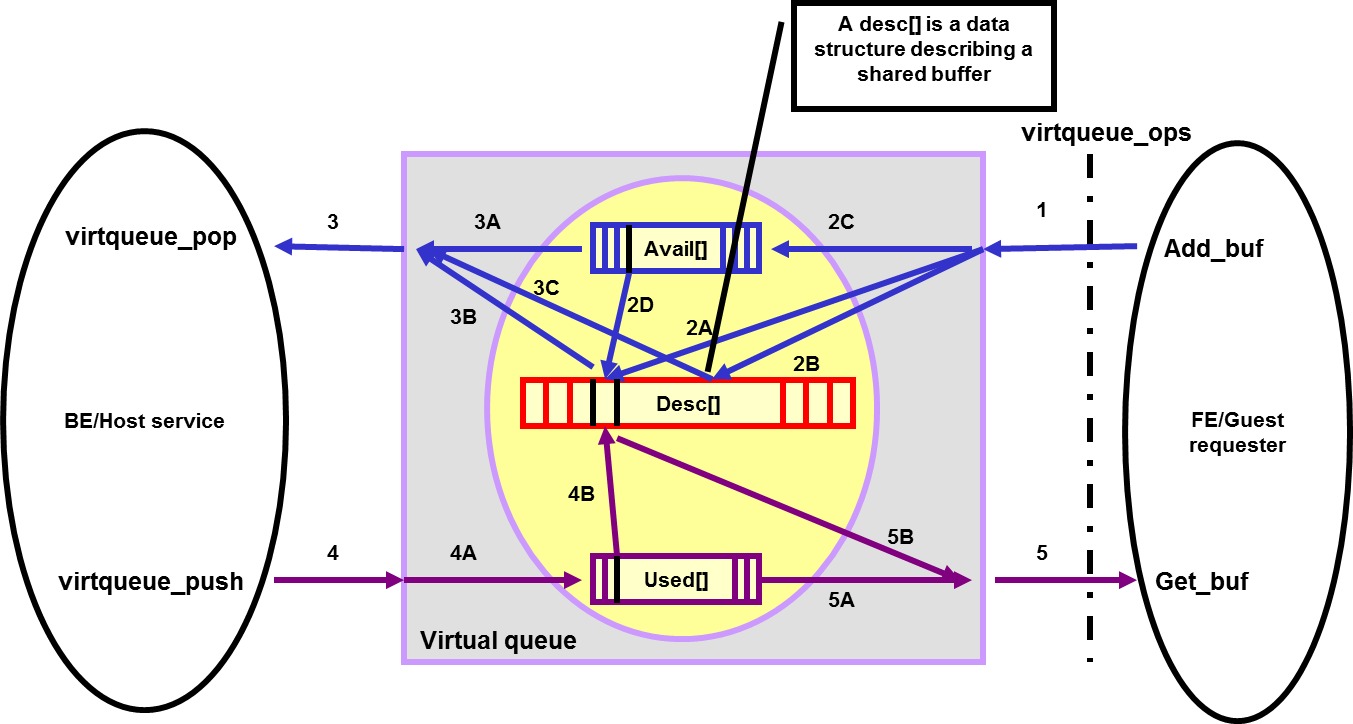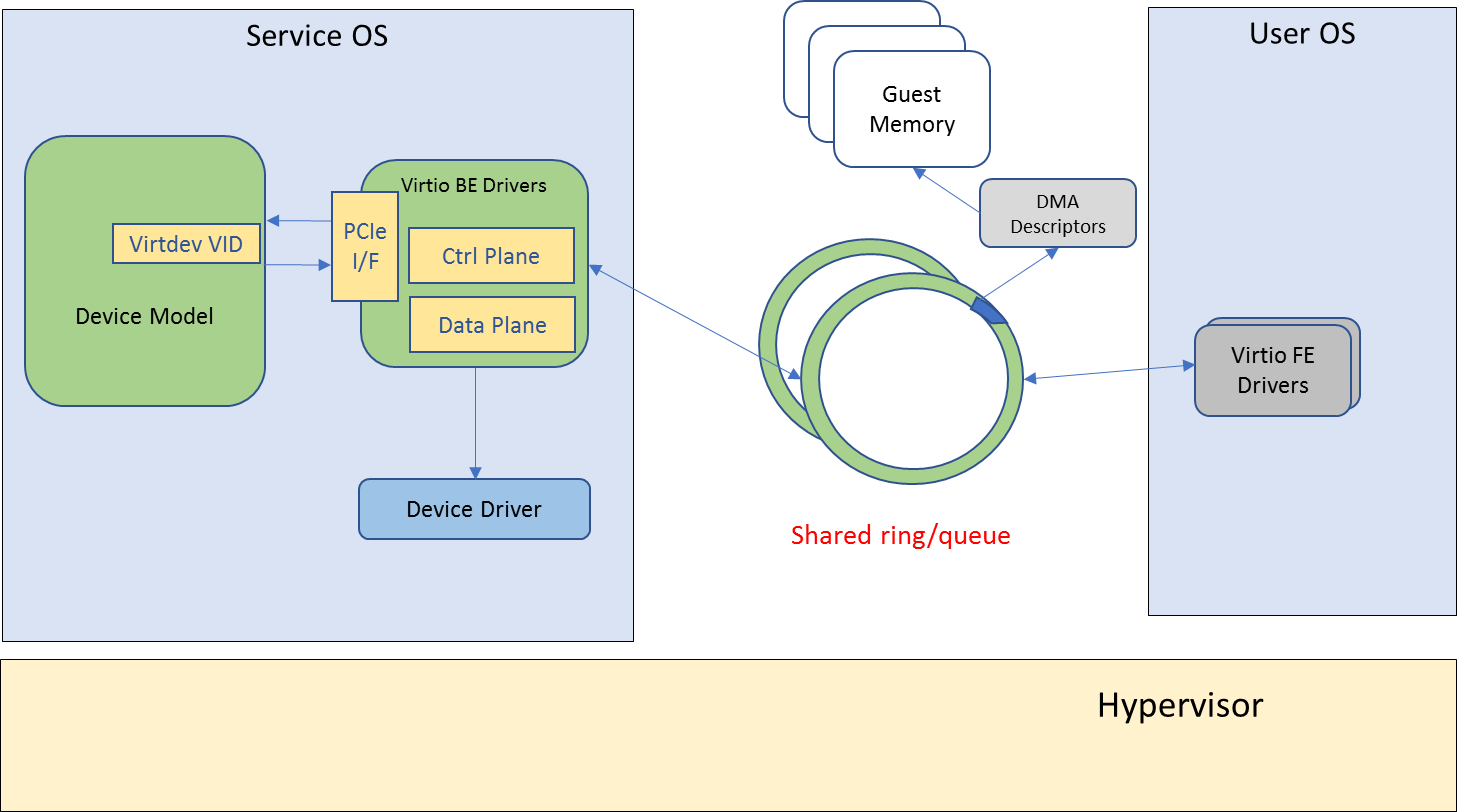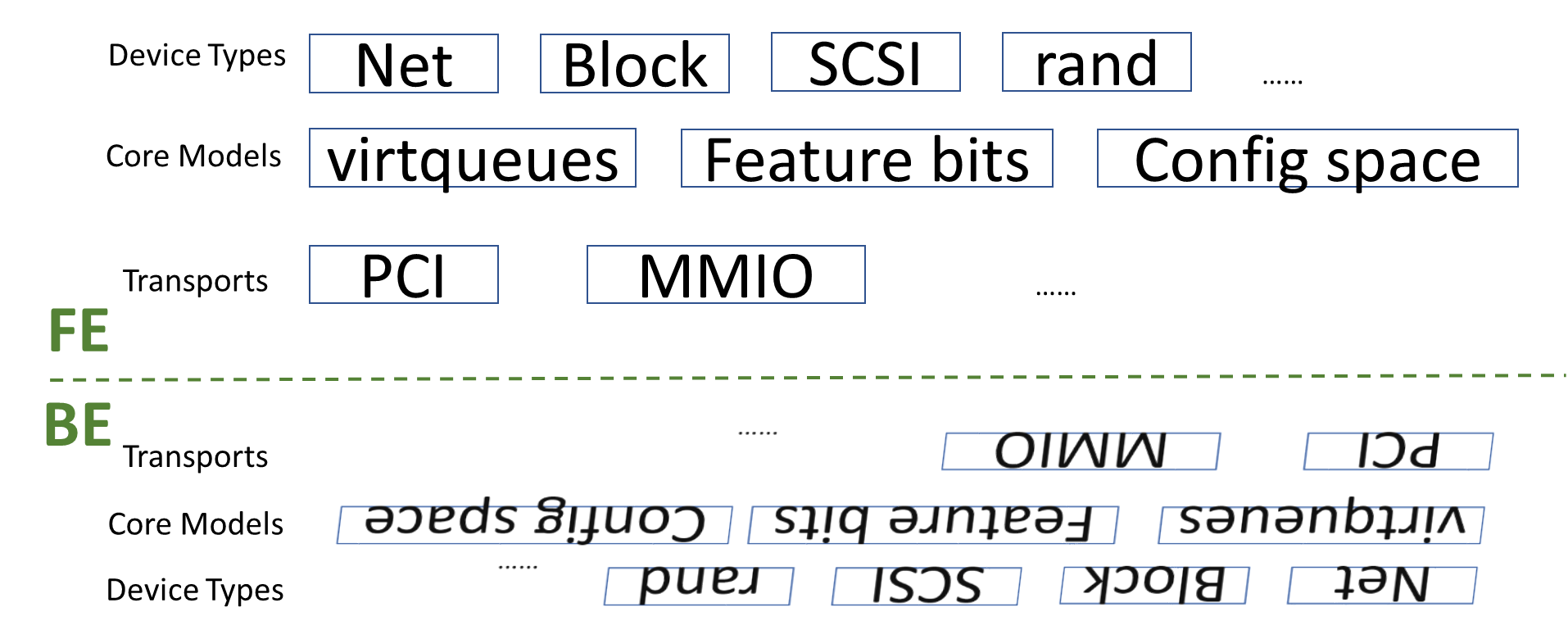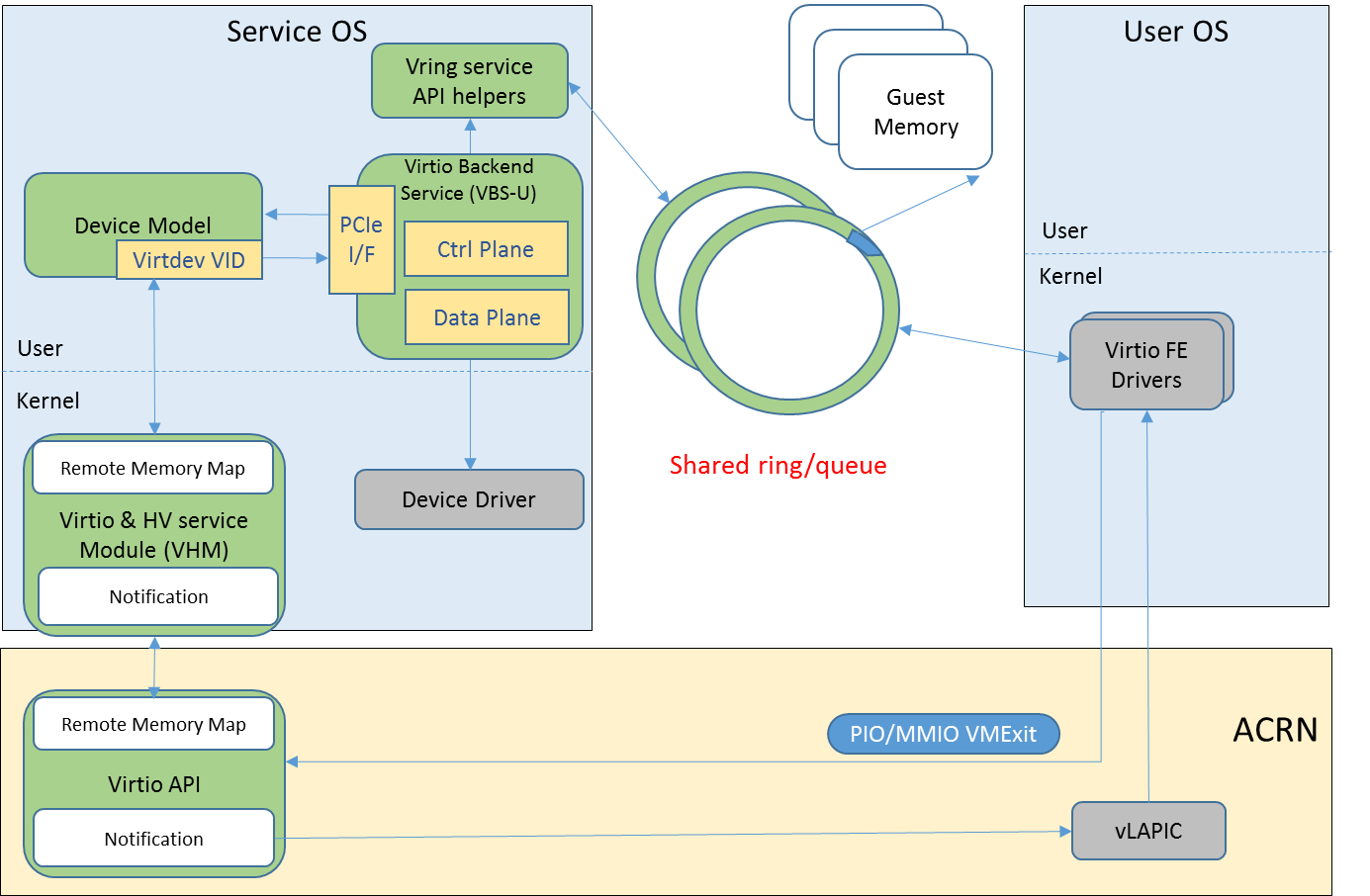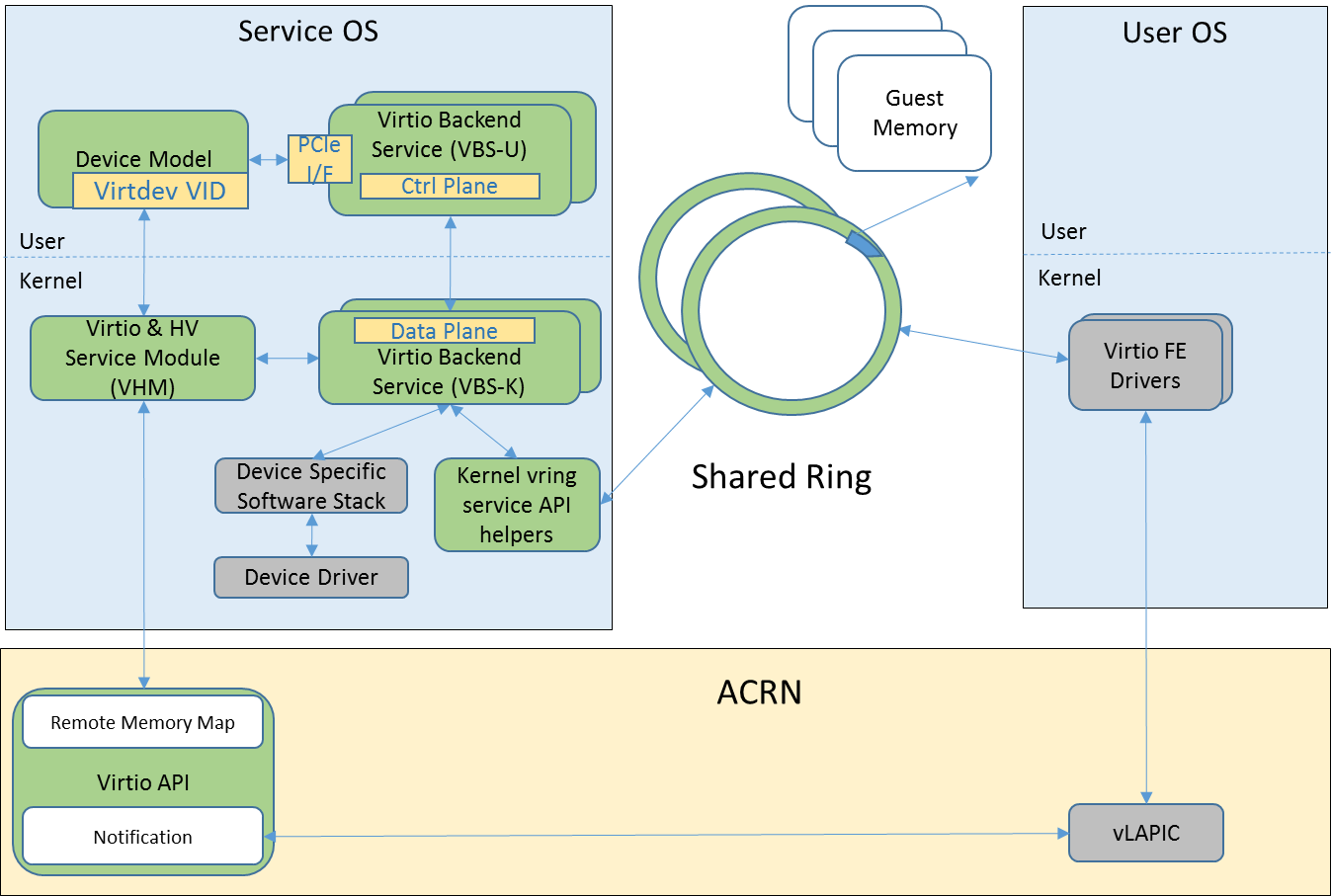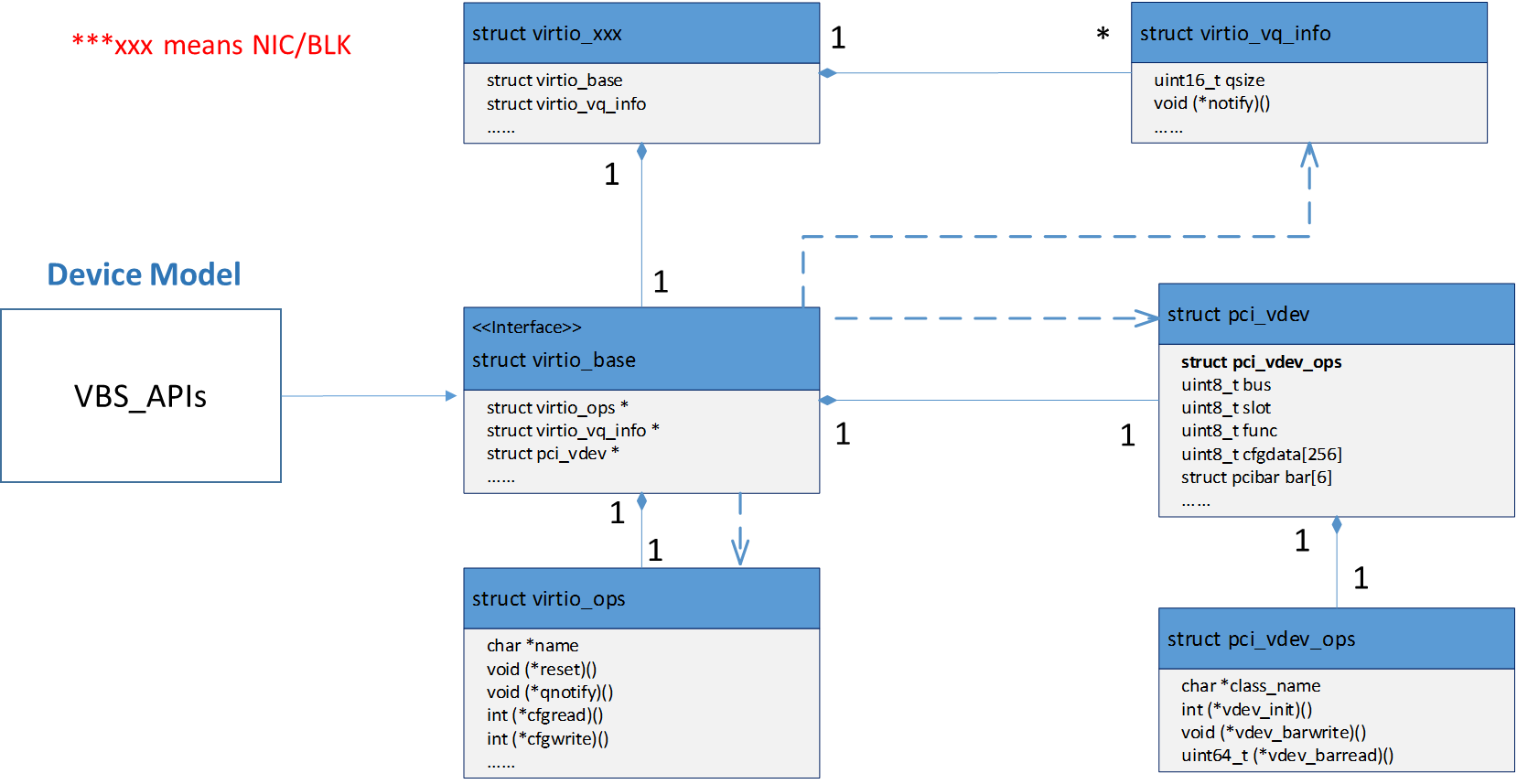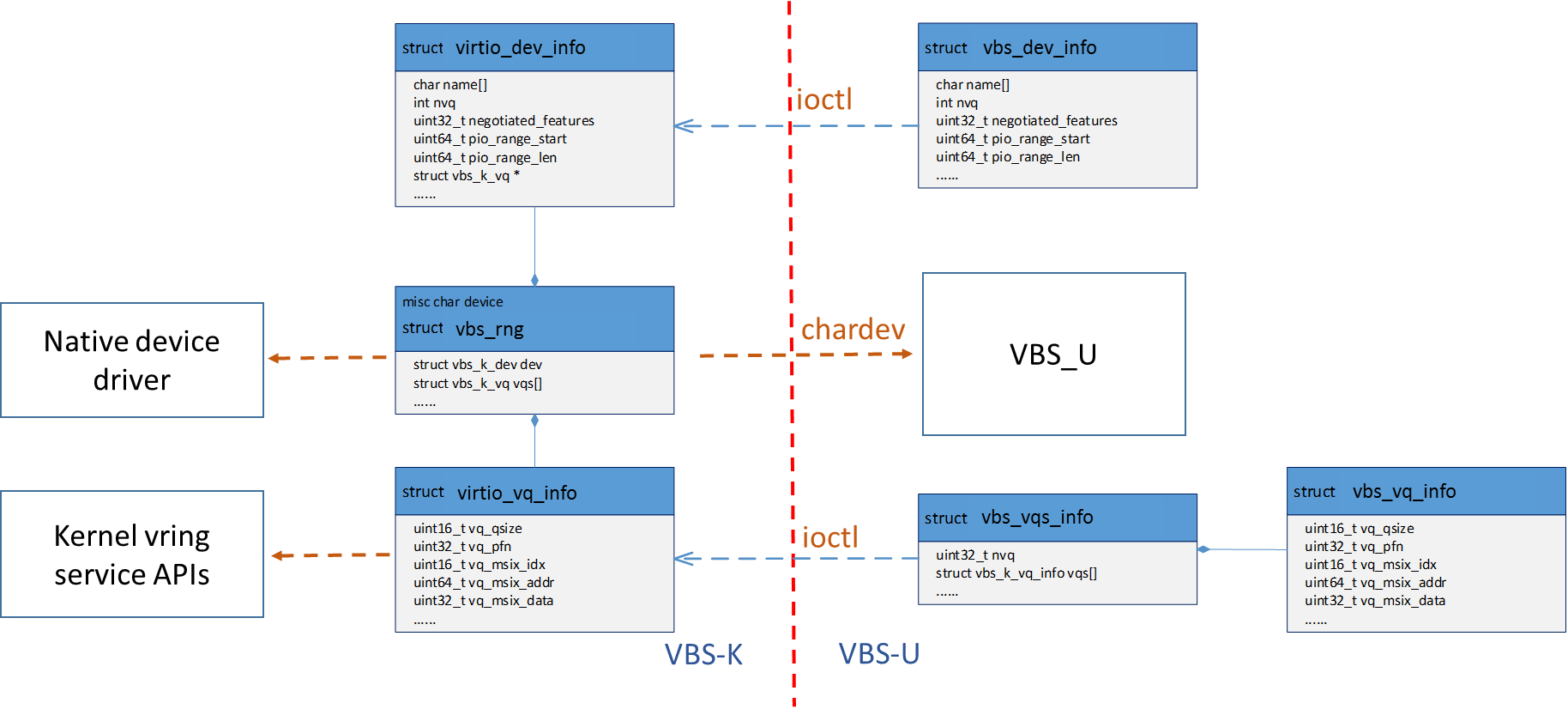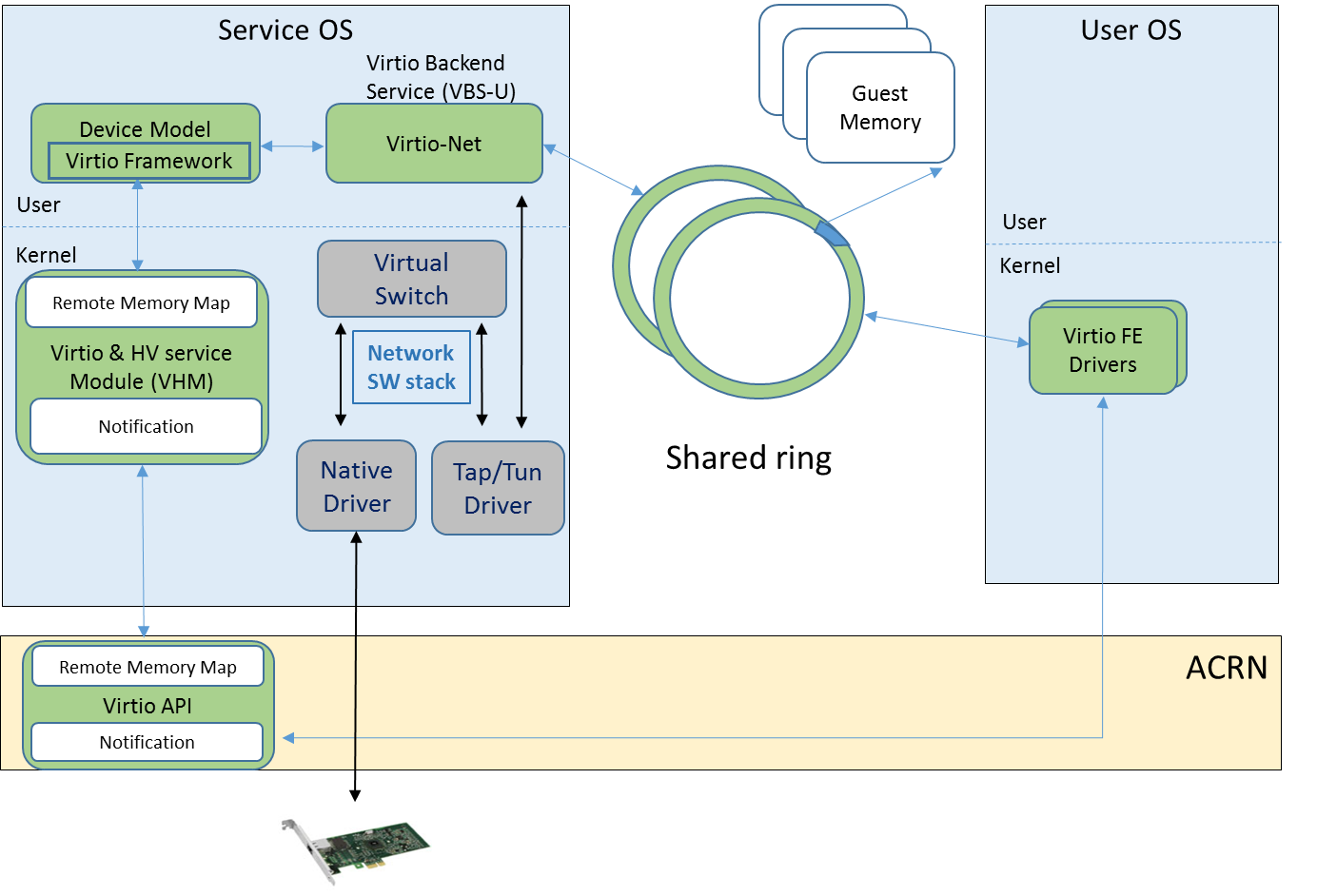Virtio High Level Design¶
The ACRN Hypervisor follows the Virtual I/O Device (virtio) specification to realize I/O virtualization for many performance-critical devices supported in the ACRN project. Adopting the virtio specification lets us reuse many frontend virtio drivers already available in a Linux-based User OS, drastically reducing potential development effort for frontend virtio drivers. To further reduce the development effort of backend virtio drivers, the hypervisor provides the virtio backend service (VBS) APIs, that make it very straightforward to implement a virtio device in the hypervisor.
The virtio APIs can be divided into 3 groups: DM APIs, virtio backend service (VBS) APIs, and virtqueue (VQ) APIs, as shown in Figure 30.
- DM APIs are exported by the DM, and are mainly used during the device initialization phase and runtime. The DM APIs also include PCIe emulation APIs because each virtio device is a PCIe device in the SOS and UOS.
- VBS APIs are mainly exported by the VBS and related modules. Generally they are callbacks to be registered into the DM.
- VQ APIs are used by a virtio backend device to access and parse information from the shared memory between the frontend and backend device drivers.
Virtio Device¶
Virtio framework is the para-virtualization specification that ACRN follows to implement I/O virtualization of performance-critical devices such as audio, eAVB/TSN, IPU, and CSMU devices. This section gives an overview about virtio history, motivation, and advantages, and then highlights virtio key concepts. Second, this section will describe ACRN’s virtio architectures, and elaborates on ACRN virtio APIs. Finally this section will introduce all the virtio devices currently supported by ACRN.
Introduction¶
Virtio is an abstraction layer over devices in a para-virtualized hypervisor. Virtio was developed by Rusty Russell when he worked at IBM research to support his lguest hypervisor in 2007, and it quickly became the de-facto standard for KVM’s para-virtualized I/O devices.
Virtio is very popular for virtual I/O devices because is provides a straightforward, efficient, standard, and extensible mechanism, and eliminates the need for boutique, per-environment, or per-OS mechanisms. For example, rather than having a variety of device emulation mechanisms, virtio provides a common frontend driver framework that standardizes device interfaces, and increases code reuse across different virtualization platforms.
Given the advantages of virtio, ACRN also follows the virtio specification.
Key Concepts¶
To better understand virtio, especially its usage in ACRN, we’ll highlight several key virtio concepts important to ACRN:
- Frontend virtio driver (FE)
- Virtio adopts a frontend-backend architecture that enables a simple but flexible framework for both frontend and backend virtio drivers. The FE driver merely needs to offer services configure the interface, pass messages, produce requests, and kick backend virtio driver. As a result, the FE driver is easy to implement and the performance overhead of emulating a device is eliminated.
- Backend virtio driver (BE)
Similar to FE driver, the BE driver, running either in user-land or kernel-land of the host OS, consumes requests from the FE driver and sends them to the host native device driver. Once the requests are done by the host native device driver, the BE driver notifies the FE driver that the request is complete.
Note: to distinguish BE driver from host native device driver, the host native device driver is called “native driver” in this document.
- Straightforward: virtio devices as standard devices on existing buses
Instead of creating new device buses from scratch, virtio devices are built on existing buses. This gives a straightforward way for both FE and BE drivers to interact with each other. For example, FE driver could read/write registers of the device, and the virtual device could interrupt FE driver, on behalf of the BE driver, in case something of interest is happening.
Currently virtio supports PCI/PCIe bus and MMIO bus. In ACRN, only PCI/PCIe bus is supported, and all the virtio devices share the same vendor ID 0x1AF4.
Note: For MMIO, the “bus” is a little bit an overstatement since basically it is a few descriptors describing the devices.
- Efficient: batching operation is encouraged
- Batching operation and deferred notification are important to achieve high-performance I/O, since notification between FE and BE driver usually involves an expensive exit of the guest. Therefore batching operating and notification suppression are highly encouraged if possible. This will give an efficient implementation for performance-critical devices.
- Standard: virtqueue
All virtio devices share a standard ring buffer and descriptor mechanism, called a virtqueue, shown in Figure 31. A virtqueue is a queue of scatter-gather buffers. There are three important methods on virtqueues:
- add_buf is for adding a request/response buffer in a virtqueue,
- get_buf is for getting a response/request in a virtqueue, and
- kick is for notifying the other side for a virtqueue to consume buffers.
The virtqueues are created in guest physical memory by the FE drivers. BE drivers only need to parse the virtqueue structures to obtain the requests and process them. How a virtqueue is organized is specific to the Guest OS. In the Linux implementation of virtio, the virtqueue is implemented as a ring buffer structure called vring.
In ACRN, the virtqueue APIs can be leveraged directly so that users don’t need to worry about the details of the virtqueue. (Refer to guest OS for more details about the virtqueue implementation.)
- Extensible: feature bits
- A simple extensible feature negotiation mechanism exists for each virtual device and its driver. Each virtual device could claim its device specific features while the corresponding driver could respond to the device with the subset of features the driver understands. The feature mechanism enables forward and backward compatibility for the virtual device and driver.
- Virtio Device Modes
The virtio specification defines three modes of virtio devices: a legacy mode device, a transitional mode device, and a modern mode device. A legacy mode device is compliant to virtio specification version 0.95, a transitional mode device is compliant to both 0.95 and 1.0 spec versions, and a modern mode device is only compatible to the version 1.0 specification.
In ACRN, all the virtio devices are transitional devices, meaning that they should be compatible with both 0.95 and 1.0 versions of virtio specification.
- Virtio Device Discovery
Virtio devices are commonly implemented as PCI/PCIe devices. A virtio device using virtio over PCI/PCIe bus must expose an interface to the Guest OS that meets the PCI/PCIe specifications.
Conventionally, any PCI device with Vendor ID 0x1AF4, PCI_VENDOR_ID_REDHAT_QUMRANET, and Device ID 0x1000 through 0x107F inclusive is a virtio device. Among the Device IDs, the legacy/transitional mode virtio devices occupy the first 64 IDs ranging from 0x1000 to 0x103F, while the range 0x1040-0x107F belongs to virtio modern devices. In addition, the Subsystem Vendor ID should reflect the PCI/PCIe vendor ID of the environment, and the Subsystem Device ID indicates which virtio device is supported by the device.
Virtio Frameworks¶
This section describes the overall architecture of virtio, and then introduce ACRN specific implementations of the virtio framework.
Architecture¶
Virtio adopts a frontend-backend architecture, as shown in Figure 32. Basically the FE and BE driver communicate with each other through shared memory, via the virtqueues. The FE driver talks to the BE driver in the same way it would talk to a real PCIe device. The BE driver handles requests from the FE driver, and notifies the FE driver if the request has been processed.
In addition to virtio’s frontend-backend architecture, both FE and BE drivers follow a layered architecture, as shown in Figure 33. Each side has three layers: transports, core models, and device types. All virtio devices share the same virtio infrastructure, including virtqueues, feature mechanisms, configuration space, and buses.
Virtio Framework Considerations¶
How to realize the virtio framework is specific to a hypervisor implementation. In ACRN, the virtio framework implementations can be classified into two types, virtio backend service in user-land (VBS-U) and virtio backend service in kernel-land (VBS-K), according to where the virtio backend service (VBS) is located. Although different in BE drivers, both VBS-U and VBS-K share the same FE drivers. The reason behind the two virtio implementations is to meet the requirement of supporting a large amount of diverse I/O devices in ACRN project.
When developing a virtio BE device driver, the device owner should choose carefully between the VBS-U and VBS-K. Generally VBS-U targets non-performance-critical devices, but enables easy development and debugging. VBS-K targets performance critical devices.
The next two sections introduce ACRN’s two implementations of the virtio framework.
User-Land Virtio Framework¶
The architecture of ACRN user-land virtio framework (VBS-U) is shown in Figure 34.
The FE driver talks to the BE driver as if it were talking with a PCIe device. This means for “control plane”, the FE driver could poke device registers through PIO or MMIO, and the device will interrupt the FE driver when something happens. For “data plane”, the communication between the FE and BE driver is through shared memory, in the form of virtqueues.
On the service OS side where the BE driver is located, there are several key components in ACRN, including device model (DM), virtio and HV service module (VHM), VBS-U, and user-level vring service API helpers.
DM bridges the FE driver and BE driver since each VBS-U module emulates a PCIe virtio device. VHM bridges DM and the hypervisor by providing remote memory map APIs and notification APIs. VBS-U accesses the virtqueue through the user-level vring service API helpers.
Kernel-Land Virtio Framework¶
The architecture of ACRN kernel-land virtio framework (VBS-K) is shown in Figure 35.
VBS-K provides acceleration for performance critical devices emulated by VBS-U modules by handling the “data plane” of the devices directly in the kernel. When VBS-K is enabled for certain device, the kernel-land vring service API helpers are used to access the virtqueues shared by the FE driver. Compared to VBS-U, this eliminates the overhead of copying data back-and-forth between user-land and kernel-land within the service OS, but pays with the extra implementation complexity of the BE drivers.
Except for the differences mentioned above, VBS-K still relies on VBS-U for feature negotiations between FE and BE drivers. This means the “control plane” of the virtio device still remains in VBS-U. When feature negotiation is done, which is determined by FE driver setting up an indicative flag, VBS-K module will be initialized by VBS-U, after which all request handling will be offloaded to the VBS-K in kernel.
The FE driver is not aware of how the BE driver is implemented, either in the VBS-U or VBS-K model. This saves engineering effort regarding FE driver development.
Virtio APIs¶
This section provides details on the ACRN virtio APIs. As outlined previously, the ACRN virtio APIs can be divided into three groups: DM_APIs, VBS_APIs, and VQ_APIs. The following sections will elaborate on these APIs.
VBS-U Key Data Structures¶
The key data structures for VBS-U are listed as following, and their relationships are shown in Figure 36.
struct pci_virtio_blk- An example virtio device, such as virtio-blk.
struct virtio_common- A common component to any virtio device.
struct virtio_ops- Virtio specific operation functions for this type of virtio device.
struct pci_vdev- Instance of a virtual PCIe device, and any virtio device is a virtual PCIe device.
struct pci_vdev_ops- PCIe device’s operation functions for this type of device.
struct vqueue_info- Instance of a virtqueue.
Each virtio device is a PCIe device. In addition, each virtio device
could have none or multiple virtqueues, depending on the device type.
The struct virtio_common is a key data structure to be manipulated by
DM, and DM finds other key data structures through it. The struct
virtio_ops abstracts a series of virtio callbacks to be provided by
device owner.
VBS-K Key Data Structures¶
The key data structures for VBS-K are listed as follows, and their relationships are shown in Figure 37.
struct vbs_k_rng- In-kernel VBS-K component handling data plane of a VBS-U virtio device, for example virtio random_num_generator.
struct vbs_k_dev- In-kernel VBS-K component common to all VBS-K.
struct vbs_k_vq- In-kernel VBS-K component to be working with kernel vring service API helpers.
struct vbs_k_dev_inf- Virtio device information to be synchronized from VBS-U to VBS-K kernel module.
struct vbs_k_vq_info- A single virtqueue information to be synchronized from VBS-U to VBS-K kernel module.
struct vbs_k_vqs_info- Virtqueue(s) information, of a virtio device, to be synchronized from VBS-U to VBS-K kernel module.
In VBS-K, the struct vbs_k_xxx represents the in-kernel component handling a virtio device’s data plane. It presents a char device for VBS-U to open and register device status after feature negotiation with the FE driver.
The device status includes negotiated features, number of virtqueues,
interrupt information, and more. All these status will be synchronized
from VBS-U to VBS-K. In VBS-U, the struct vbs_k_dev_info and struct
vbs_k_vqs_info will collect all the information and notify VBS-K through
ioctls. In VBS-K, the struct vbs_k_dev and struct vbs_k_vq, which are
common to all VBS-K modules, are the counterparts to preserve the
related information. The related information is necessary to kernel-land
vring service API helpers.
DM APIs¶
The DM APIs are exported by DM, and they should be used when realizing BE device drivers on ACRN.
[API Material from doxygen comments]
VBS APIs¶
The VBS APIs are exported by VBS related modules, including VBS, DM, and SOS kernel modules. They can be classified into VBS-U and VBS-K APIs listed as follows.
VBS-U APIs¶
These APIs provided by VBS-U are callbacks to be registered to DM, and the virtio framework within DM will invoke them appropriately.
[API Material from doxygen comments]
VBS-K APIs¶
The VBS-K APIs are exported by VBS-K related modules. Users could use the following APIs to implement their VBS-K modules.
APIs provided by DM¶
[API Material from doxygen comments]
APIs provided by VBS-K modules in service OS¶
VQ APIs¶
The virtqueue APIs, or VQ APIs, are used by a BE device driver to access the virtqueues shared by the FE driver. The VQ APIs abstract the details of virtqueues so that users don’t need to worry about the data structures within the virtqueues. In addition, the VQ APIs are designed to be identical between VBS-U and VBS-K, so that users don’t need to learn different APIs when implementing BE drivers based on VBS-U and VBS-K.
[API Material from doxygen comments]
Below is an example showing a typical logic of how a BE driver handles requests from a FE driver.
static void BE_callback(struct pci_virtio_xxx *pv, struct vqueue_info *vq ) {
while (vq_has_descs(vq)) {
vq_getchain(vq, &idx, &iov, 1, NULL);
/* handle requests in iov */
request_handle_proc();
/* Release this chain and handle more */
vq_relchain(vq, idx, len);
}
/* Generate interrupt if appropriate. 1 means ring empty \*/
vq_endchains(vq, 1);
}
Current Virtio Devices¶
This section introduces the status of the current virtio devices supported in ACRN. All the BE virtio drivers are implemented using the ACRN virtio APIs, and the FE drivers are reusing the standard Linux FE virtio drivers. For the devices with FE drivers available in the Linux kernel, they should use standard virtio Vendor ID/Device ID and Subsystem Vendor ID/Subsystem Device ID. For other devices within ACRN, their temporary IDs are listed in the following table.
| virtio device | Vendor ID | Device ID | Subvendor ID | Subdevice ID |
| RPMB | 0x8086 | 0x8601 | 0x8086 | 0xFFFF |
| HECI | 0x8086 | 0x8602 | 0x8086 | 0xFFFE |
| audio | 0x8086 | 0x8603 | 0x8086 | 0xFFFD |
| IPU | 0x8086 | 0x8604 | 0x8086 | 0xFFFC |
| TSN/AVB | 0x8086 | 0x8605 | 0x8086 | 0xFFFB |
| hyper_dmabuf | 0x8086 | 0x8606 | 0x8086 | 0xFFFA |
| HDCP | 0x8086 | 0x8607 | 0x8086 | 0xFFF9 |
| COREU | 0x8086 | 0x8608 | 0x8086 | 0xFFF8 |
Virtio-rnd¶
The virtio-rnd entropy device supplies high-quality randomness for guest use. The virtio device ID of the virtio-rnd device is 4, and it supports one virtqueue, the size of which is 64, configurable in the source code. It has no feature bits defined.
When the FE driver requires some random bytes, the BE device will place bytes of random data onto the virtqueue.
To launch the virtio-rnd device, use the following virtio command:
-s <slot>,virtio-rnd
To verify the correctness in user OS, use the following command:
od /dev/random
Virtio-blk¶
The virtio-blk device is a simple virtual block device. The FE driver places read, write, and other requests onto the virtqueue, so that the BE driver can process them accordingly.
The virtio device ID of the virtio-blk is 2, and it supports one virtqueue, the size of which is 64, configurable in the source code. The feature bits supported by the BE device are shown as follows:
- VTBLK_F_SEG_MAX(bit 2)
- Maximum number of segments in a request is in seg_max.
- VTBLK_F_BLK_SIZE(bit 6)
- block size of disk is in blk_size.
- VTBLK_F_FLUSH(bit 9)
- cache flush command support.
- VTBLK_F_TOPOLOGY(bit 10)
- device exports information on optimal I/O alignment.
To use the virtio-blk device, use the following virtio command:
-s <slot>,virtio-blk,<filepath>
Successful booting of the User OS verifies the correctness of the device.
Virtio-net¶
The virtio-net device is a virtual Ethernet device. The virtio device ID of the virtio-net is 1, and ACRN’s virtio-net device supports twp virtqueues, one for transmitting packets and the other for receiving packets. The FE driver places empty buffers onto one virtqueue for receiving packets, and enqueue outgoing packets onto another virtqueue for transmission. Currently the size of each virtqueue is 1000, configurable in the source code.
To access the external network from user OS, as shown in Figure 38, a L2 virtual switch should be created in the service OS, and the BE driver is bonded to a tap/tun device linking under the L2 virtual switch.
Currently the feature bits supported by the BE device are shown as follows:
- VIRTIO_NET_F_MAC(bit 5)
- device has given MAC address.
- VIRTIO_NET_F_MRG_RXBUF(bit 15)
- BE driver can merge receive buffers.
- VIRTIO_NET_F_STATUS(bit 16)
- configuration status field is available.
- VIRTIO_F_NOTIFY_ON_EMPTY(bit 24)
- device will issue an interrupt if it runs out of available descriptors on a virtqueue.
To enable the virtio-net device, use the following virtio command:
-s <slot>,virtio-net,<vale/tap/vmnet>
To verify the correctness of the device, access the external network within the user OS.
Virtio-console¶
The virtio-console device is a simple device for data input and output. The virtio device ID of the virtio-console device is 3. A device could have one or up to 16 ports in ACRN. Each port has a pair of input and output virtqueues. A device has a pair of control virtqueues, which are used to communicate information between the FE and BE drivers. Currently the size of each virtqueue is 64, configurable in the source code.
Similar to virtio-net device, two virtqueues specific to a port are transmitting virtqueue and receiving virtqueue. The FE driver places empty buffers onto the receiving virtqueue for incoming data, and enqueues outgoing characters onto transmitting virtqueue.
Currently the feature bits supported by the BE device are shown as follows:
- VTCON_F_SIZE(bit 0)
- configuration columns and rows are valid.
- VTCON_F_MULTIPORT(bit 1)
- device supports multiple ports, and control virtqueues will be used.
- VTCON_F_EMERG_WRITE(bit 2)
- device supports emergency write.
To use the virtio-console device, use the following virtio command:
-s <slot>,virtio-console,[@]<stdio|tty|pty|sock>:<portname>[=portpath]
Note
Here are some notes about the virtio-console device:
@: marks the port as a console port, otherwise it is a normal virtio serial port- stdio/tty/pty: tty capable, which means TAB and BACKSPACE are supported as in regular terminals
- When tty are used, please make sure the redirected tty is sleep, e.g. by “sleep 2d” command, and will not read input from stdin before it is used by virtio-console to redirect guest output;
- Claiming multiple virtio serial ports as consoles are supported, however the guest Linux will only use one of them, through “console=hvcN” kernel parameters, as the hvc.

